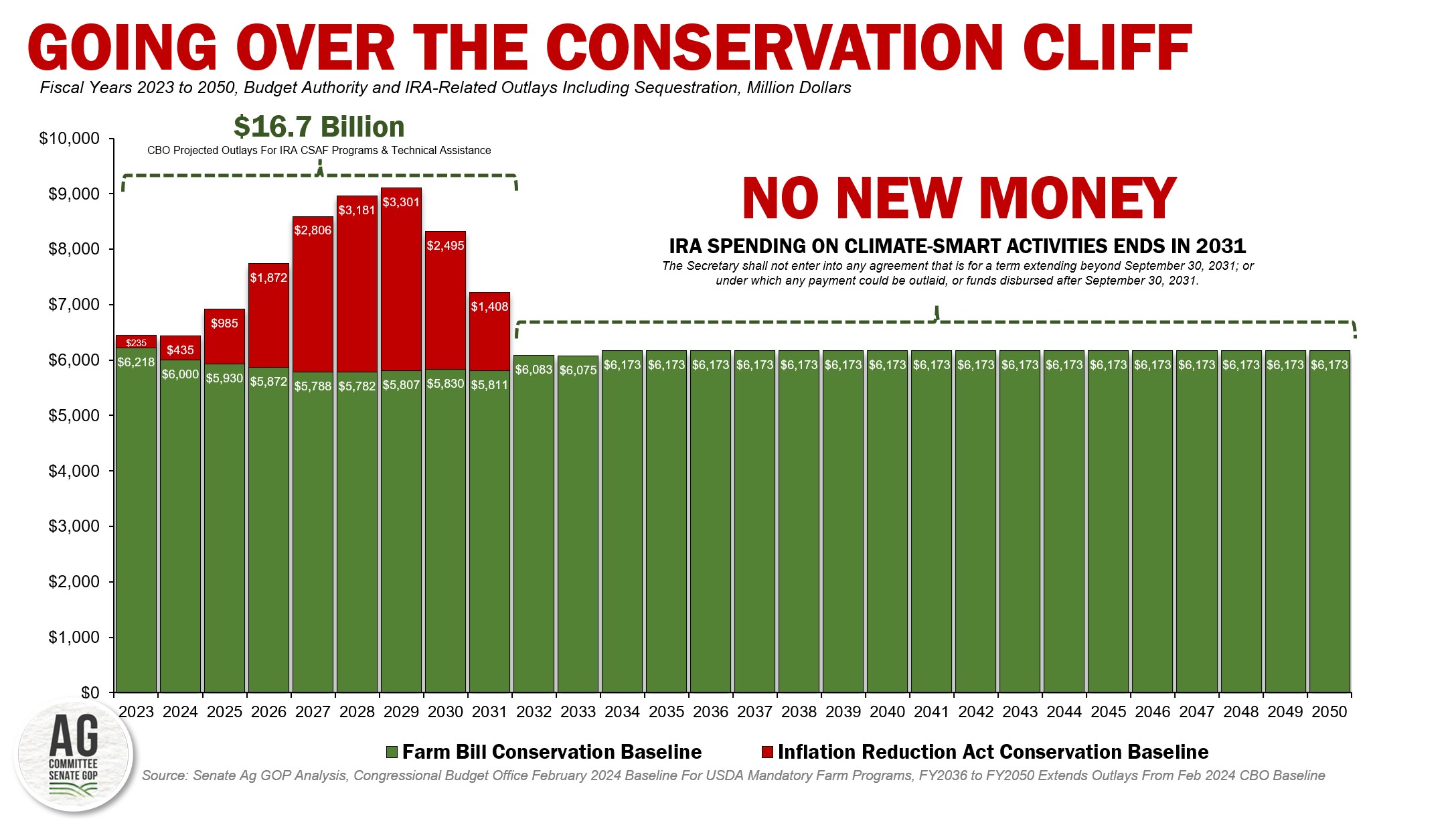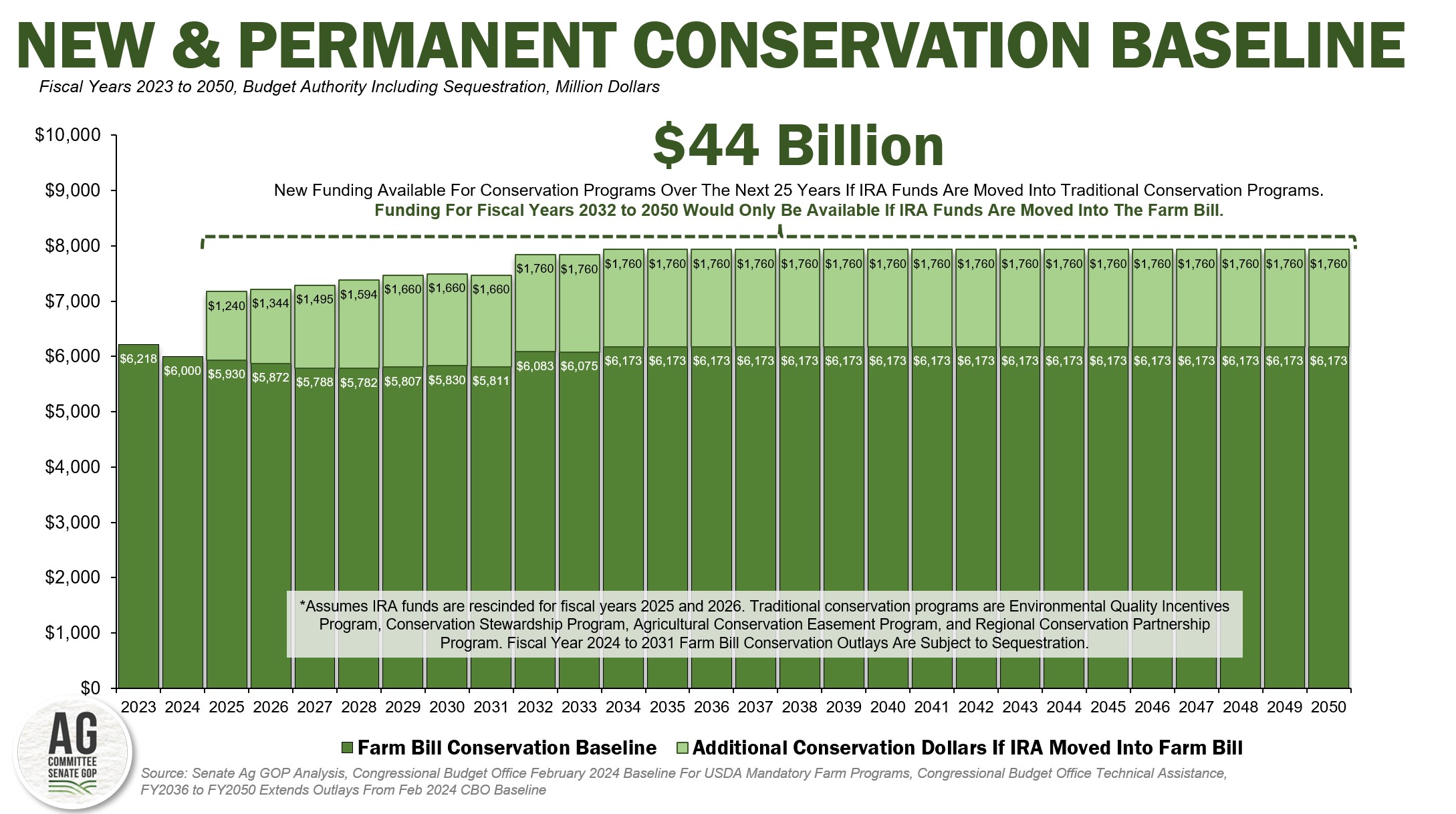Avoiding The Conservation Cliff – A Bipartisan Solution
Key Takeaways
- Congress has a historic opportunity to make a meaningful and permanent increase in funding for locally-led conservation, natural resource preservation, and wildlife habitat needs by moving Inflation Reduction Act (IRA) dollars into a bipartisan farm bill.
- Over the next 25 years this additional investment in conservation spending could be more than $44 billion and three times larger than the expiring resources provided by the IRA.
- Any discussion about “protecting IRA resources” that does not begin with prioritizing additional baseline for the conservation title risks missing out on this investment.
Background On The “Conservation Cliff”
The Inflation Reduction Act of 2022 (IRA) provided more than $17 billion in new funding authority for climate-smart agriculture and forestry activities (CSAF) like cover crops through existing U.S. Department of Agriculture (USDA) programs such as the Environmental Quality Incentives Program, Conservation Stewardship Program, or the Regional Conservation Partnership Program. According to the Congressional Budget Office (CBO) IRA climate and agriculture-related spending on greenhouse gas-mitigating or carbon-sequestering activities is projected at $16.7 billion from fiscal years 2023 to 2031.
Because the IRA prevents USDA from entering into any agreement that extends or disburses any funds after September 30, 2031, there is a looming conservation cliff for all IRA-related conservation activities.

There is a bipartisan solution to the conservation cliff. The budget authority provided for CSAF activities in the IRA can be moved as part of reauthorization of the farm bill to create new and permanent funding streams for all conservation activities, i.e., increased funding for conservation, natural resource preservation, and wildlife habitat efforts now and for generations to come.
How does this farm bill math work? Section 257 of the Balanced Budget and Emergency Deficit Control Act of 1985 requires CBO to assume that the current law – and funding levels – will remain in place for mandatory programs like farm bill conservation programs or commodity support programs when estimating spending projections. As a result, if the IRA dollars are moved into the conservation title as part of a bipartisan farm bill, the new increased funding levels, or new baseline, will continue for conservation programs into perpetuity – subject only to Congressional reauthorizations.
A Historic Bipartisan Investment In Conservation Programs
For illustration purposes, if, as part of a bipartisan farm bill, an agreement could be made to rescind the fiscal year 2025 and 2026 funding for IRA agriculture conservation programs totaling more than $13 billion, new conservation-related spending authority reaching nearly $1.8 billion per year could be provided to local communities, farmers, and ranchers to meet their locally-led conservation goals now and permanently into the future.
This could represent a nearly 30% increase in the conservation title’s available funding into perpetuity. Cumulatively, over the next 25 years this additional investment in conservation spending could be more than $44 billion and three times larger than the expiring resources provided by the IRA.

Moving IRA funds into the farm bill could represent a historic bipartisan investment to help farmers, ranchers, foresters, conservationists, and other stakeholders meet their local conservation needs. Any discussion about “protecting IRA resources” that does not begin with prioritizing additional baseline for the conservation title risks missing out on this investment.
Conclusion
Farmers, ranchers, and foresters across the U.S. depend upon voluntary conservation programs authorized as part of the farm bill to meet their locally-led conservation, natural resource, and wildlife habitat needs. It is well documented that demand for conservation program spending exceeds available dollars.
Congress, conservation stakeholders, and most importantly our agriculture community have a once-in-a-generation opportunity to make a meaningful and permanent increase in funding for locally-led conservation, natural resource preservation, and wildlife habitat needs by moving the IRA dollars authorized as part of the partisan reconciliation process into a bipartisan farm bill. This could allow Congress to respond to requests for additional resources to address local conservation needs, such as the historic Western drought as outlined by a bipartisan group of senators.
While disagreements remain regarding climate requirements currently in the IRA, Senate Republicans stand ready to reach a bipartisan consensus to protect these funds. Congress has a historic opportunity to help farmers improve soil health, enhance water quality, and quantity, reduce greenhouse gas emissions, and sequester carbon while also improving the economic and environmental sustainability of the farm now and for generations to come.